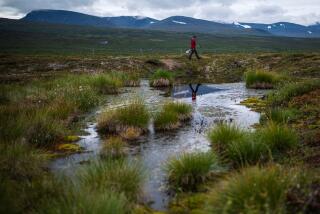SCIENCE : Tundra’s Carbon Dioxide Emissions May Spur Warming
- Share via
WASHINGTON — Reversing eons of natural history, Earth’s Arctic tundra regions and northernmost forests are no longer absorbing carbon dioxide but are instead releasing it into the atmosphere, possibly accelerating global warming, scientists from San Diego State University have discovered.
The conclusion concerns climate researchers because carbon dioxide is the “greenhouse gas” considered the chief culprit in the scientific debate over the possibility of disastrous global warming.
San Diego State biologist Walter Oechel, who led the scientific research, conducted in Alaska, described the findings as “rather startling.”
HISTORY: Across geologic time, as plants have absorbed carbon dioxide and released oxygen in the process of photosynthesis, Arctic tundra and northern forests have stored massive amounts of carbon. Carbon-dated peat deposits going back 6,000 years show a steady progression of carbon deposition in the tundra, and until the San Diego State report, carbon was believed to be continuing to build at a rate of tens of millions of tons per year.
Estimates are that the Arctic tundra now holds about a billion metric tons of carbon, with even more than that locked up in the coniferous forests of the far north. Together, the carbon equals about half the amount in the Earth’s atmosphere.
FINDINGS: Supported by the U.S. Department of Energy, the San Diego State research team began its work on Alaska’s north slope in the early 1980s, eventually developing a string of observations on a line from Prudhoe Bay along the trans-Alaska pipeline about 125 miles south to Toolik Lake.
As first reported in the journal Nature, the researchers concluded that warmer temperatures in northern Alaska have speeded the drying of tundra during the summer and lowered the water table. That, in turn, has caused more rapid decomposition of organic material in the soil--releasing carbon into the atmosphere faster than plants take it up in the process of photosynthesis.
Although the change from storage to release of carbon dioxide coincides with a period of warming temperatures, the researchers’ report cautioned that it is too early to know whether the warming is a result of increased “greenhouse gas” concentrations in the atmosphere or a localized phenomenon that is part of ever-shifting weather and climate patterns.
In an interview, Oechel speculated that his team’s observations may be an early indication of the effect changes in climate have on the functioning of ecosystems.
Participants in the study, besides Oechel, were Steven J. Hastings, George Vourlitis, Mitchell Jenkins, George Riechers, and Nancy Grulke.
BACKGROUND: The “greenhouse” phenomenon has long been recognized. Unless carbon dioxide and methane trapped a substantial amount of the sun’s energy, much of the Earth would be icebound.
But the rising atmospheric content of these gases has caused many of the world’s eminent scientists to worry that human activity will warm the climate so much that it will have a devastating impact on world agriculture and perhaps cause a disastrous rise in sea levels.
The atmosphere’s content of “greenhouse gases” is increased by massive production of carbon dioxide from burning coal and oil and generation of methane by rice paddies and cattle feedlots. It also is increased by the widespread clearing of forests, which act as carbon dioxide “sinks,” storing it in the soil.
Scientists agree that the carbon dioxide content of the atmosphere has increased about 25% since the industrial revolution. At present, the question is whether temperature increases in recent years represent normal climate variation or indicate that man-made global warming has begun.
If a sustained period of warming has indeed begun, a reversed role for the ecosystem of the Arctic could have an especially important effect.
Members of the team are now planning a collaborative effort with Russian scientists. Observations taken in Alaska will be repeated across the Russian Arctic next summer, and perhaps continued indefinitely by Russian investigators.






